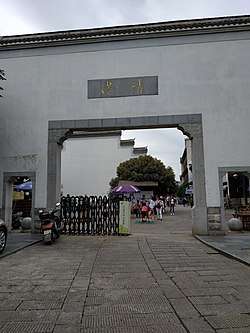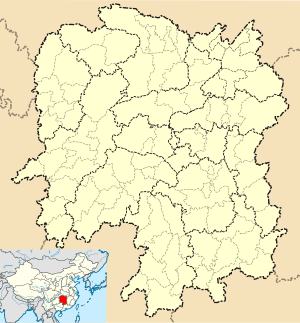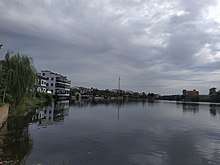Jinggang, Wangcheng
| Jinggang | |
|---|---|
| Town | |
| Chinese transcription(s) | |
| • Simplified | 靖港镇 |
| • Traditional | 靖港鎮 |
| • Pinyin | Jìnggǎng zhèn |
 Jinggang Ancient Town. | |
 Jinggang Location in Hunan | |
| Coordinates: 28°27′41″N 112°47′31″E / 28.461367°N 112.792067°ECoordinates: 28°27′41″N 112°47′31″E / 28.461367°N 112.792067°E | |
| Country |
|
| Province | Hunan |
| Prefecture-level city | Changsha |
| District | Wangcheng District |
| Area | |
| • Total | 92.47 km2 (35.70 sq mi) |
| Population | |
| • Total | 67,300 [1] |
| 2015 | |
| Time zone | UTC+8 (China Standard) |
| Area code(s) | 0731 |
Jinggang (simplified Chinese: 靖港鎮; traditional Chinese: 靖港镇; pinyin: Jìnggǎng zhèn) is a town of Wangcheng district, Changsha, China. The town is located on the west bank of Xiang river, and bordered by Qiaokou to the north, Zhuliangqiao and Shuangjiangkou of Ningxiang to the west, Gaotangling to the south, Tongguan across the Xiang river to the east. It covers 92.47 km2 (35.70 sq mi) with 67.3 thousand of population.[1] The Jinggang town was formed by the former Jinggang and Getang towns on November 19, 2015.[2] According to the result of 2016 adjustment programmes on village-level divisions (村级区划调整), the town has 2 residential communities and 10 villages under its jurisdiction; the administrative office is at Nongxi village (农溪村).[3]
History

Jinggang, also known as "Weigang" (沩港), is located at the northwest of Wangcheng District and was named so due to the general of Tang dynasty (618-907) Li Jing's (571-649) stationing here. Jinggang was firstly mentioned in National Chorography (Chinese: 《一统志》; pinyin: Yī Tǒng Zhì), which read: "Tang dynasty Li Jing fought against Xiao Xian stationing troops here."[4] In the Xianfeng period (1850-1861) of Qing dynasty (1644-1912), the Xiang Army led by Zeng Guofan (1811-1872) fought against the Taiping Army here. According to the Changsha County Annals (Chinese: 长沙县志), the book described Jinggang as "Tang dynasty Li Jing station troops here, the army doesn't commit the slightest offence against the civilians, the local people are very nostalgic for him and named the place after him."[5] From the Ming and Qing dynasties (1368-1912) to the Republican period (1912-1949), Jinggang was the well-known rice market in Hunan and distribution port of Huai salt.[6] It was one of the four rice market in Hunan and known as "Little Hankou".[7] By the end of 19th century, Jianggang had been over 90 rice shops, 5 money exchange shops, and numerous handicraft workshops and scissor-cut, woodworking, manual scale, iron forging, paper umbrella, manufacturing and other handicraft industries gave full play to their respective strong point.[8] Nearly all families on Granite Street were shops, the permanent resident population reached 40,000 and transient population exceeded 10,000. In 2008, Jinggang was rated as one of the 4th batch of "Historic and Cultural Towns in China".[6][9][10]
Subdivision
On March 23, 2016, the village-level divisions of Jinggang were adjusted from 16 to 12.[11] There 10 villages and 2 residential community in the town.
| amount of divisions: 2 residential community and 8 villages | |||
| villages and residential communities | villages and residential communities | ||
| English name | Chinese name | English name | Chinese name |
| Lujiang residential community reformed by merging the former Lujiang residential community, Nongxi and Jinxing villages on March 23, 2016 |
芦江社区 2016年3月23日由原芦江社区、农溪村和金星村合并设置 |
Zhongxing residential community reformed by merging the former Lujiang residential community, Nongxi and Jinxing villages on March 23, 2016 |
众兴社区 2016年3月23日由原众兴社区(原众兴村)、高桥村合并设置 |
| Yangjiashan village reformed by merging the former Yangjiashan village, Yuchi grous (also the former Yuchi village) of Hechi village on March 23, 2016 |
杨家山村 2016年3月23日由原杨家山村、合池村浴池片区(即原浴池村)合并设置 |
Sanqiao village reformed by merging the former Sanqiao village, Sanhe grous (also the former Sanhe village) of Hechi village on March 23, 2016 |
三桥村 2016年3月23日由原三桥村、合池村三合片区(即原三合村)合并设置 |
| Shihao village | 石毫村 | Fusheng village | 复胜村 |
| Futang village | 福塘村 | Qianbang village | 前榜村 |
| Xinfeng village | 新峰村 | Boye village | 柏叶村 |
| Lingchong village | 凌冲村 | Getang village | 格塘村 |
Attractions
Jianggang is home to Yangsi Tower (杨泗塔), Guanyin Temple (观音庙) and Ziyun Palace (紫云宫).[9][12] Guanyin Temple is a Buddhist temple and Ziyun Palace is a Taoist temple in the town. Underground CPC Hunan Provincial Committee Office Site (地下湖南省委办公遗址)、Former Residence of Liu Chouxi (刘畴西故居), Former Residence of Tao Cheng (陶承故居) are also famous scenic spots.[13]
References
- 1 2 Overview of Jinggang (2015-10-30)
- ↑ rednet.cn (2015-12-02): 2015 adjustment programmes of Hunan on township-level administrative results (2015年湖南乡镇区划调整方案), changsha.gov (2015-11-27): 2015 adjustment programmes of Wangcheng district on township-level administrative results (015年望城区乡镇区划调整方案), wangcheng.gov (2015-12-17), rednet.cn (2015-12-02), ifeng.com (2015-12-05)
- ↑ csgtzy.gov (2016-3-23): 2016 adjustment programmes on village-level divisions of Jinggang, also see mzj.wangcheng.gov (2016-03-29)
- ↑ Mu Zhang'e & Pan Xi'en: 唐李靖讨萧铣驻兵于此.
- ↑ Liu Caibang: 唐李靖驻兵于此,秋毫无犯,百姓德之,名曰靖港,以志不忘。
- 1 2 湖南历史文化名镇名村靖港镇上榜. changsha.com.cn (in Chinese). 2014-05-15.
靖港曾名芦江,因唐朝大将李靖在此驻军而得名靖港。靖港曾为三湘物资集散的繁荣商埠,美名“小汉口”,是湖南四大米市之一。清末,太平军将领石贞祥在此大败曾国藩的湘军水师,打的曾国藩两次投江自尽。
- ↑ Tang Qunxiong; Zhai Chen (2013-04-01). 传靖港为纪念李靖得名 如今再现渔樵耕读图. red.net (in Chinese).
靖港古镇具有“小汉口”之称。靖港位于沩水入湘江的三角洲地带,曾为湖南四大米市之一,又是省内淮盐主要经销口岸。
- ↑ 大美靖港如诗如画,看后真想长住这里. sohu (in Chinese). 2017-10-12.
- 1 2 Chen Xianshu (2016-10-22). “全域旅游 魅力古镇”——古镇说古之靖港篇. changsha.cn (in Chinese).
- ↑ 古镇靖港 [The Old Jinggang Town]. iFeng (in Chinese). 2014-05-28.
- 1 2 The full result of the village-level administrative division adjustment of Wangcheng in March 2016
- ↑ 靖港古镇 繁华美丽的水乡古镇. Tencent (in Chinese). 2016-04-07.
- ↑ 年味长沙 寻觅历史的足迹靖港古镇. sohu (in Chinese). 2015-02-13.
External links
- A Millennium Historic Town: Jinggang (in Chinese)
- Mu Zhang'e; Pan Xi'en (2008). 《大清一统志》 [National Chorography of Great Qing] (in Chinese). Shanghai: Shanghai Classics Publishing House. ISBN 9787532547418.
- Liu Caibang (2010). 《长沙县志》 [Changsha County Annals] (in Chinese). Changsha, Hunan: Yuelu Shushe. ISBN 9787807612841.
- 《靖港史话》 [Historical Narrative of Jinggang] (in Chinese). Contemporary Chinese Publishing House. 2009-09-01. ISBN 9787801708625.
